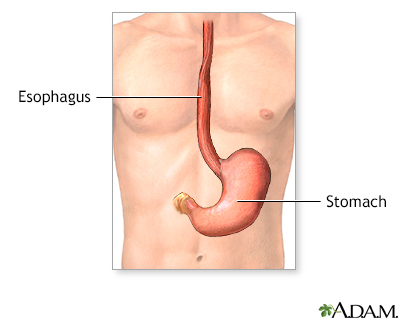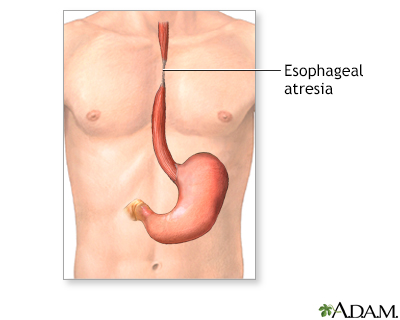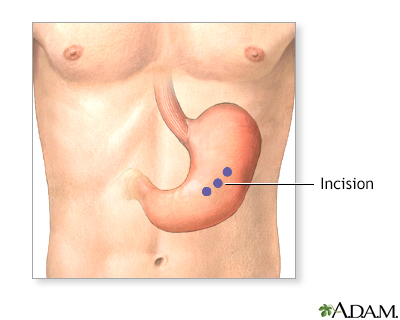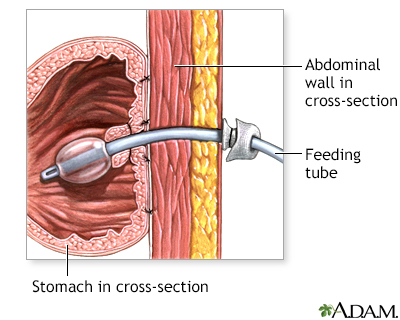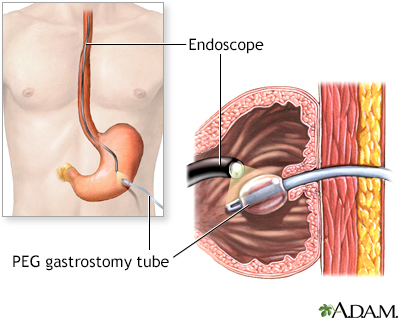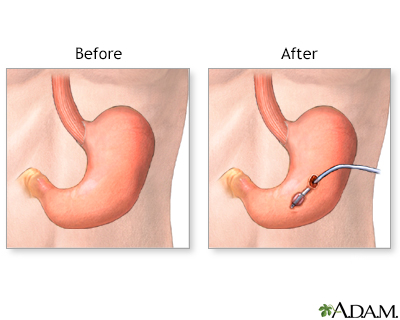PEG tube insertion - discharge
Gastrostomy tube insertion-discharge; G-tube insertion-discharge; PEG tube insertion-discharge; Stomach tube insertion-discharge; Percutaneous endoscopic gastrostomy tube insertion-dischargeA PEG (percutaneous endoscopic gastrostomy) feeding tube insertion is the placement of a feeding tube through the skin and the stomach wall. It goes directly into the stomach. PEG feeding tube insertion is done in part using a procedure called endoscopy.
Feeding tube insertion
A gastrostomy feeding tube (G-tube) insertion is the placement of a feeding tube through the skin and the stomach wall. It goes directly into the st...

Feeding tubes are needed when you are unable to eat or drink. This may be due to stroke or other brain injury, problems with the esophagus, surgery of the head and neck, or other conditions.
Your PEG tube is easy to use. You (or your caregiver) can learn to care for it on your own and even give yourself tube feedings.
About PEG Tubes
Here are the important parts of your PEG tube:
- PEG/Gastrostomy feeding tube.
- 2 small discs that are on the outside and the inside of the gastrostomy opening (or stoma) in your stomach wall. These discs prevent the feeding tube from moving. The disc on the outside is very close to the skin.
- A clamp to close off the feeding tube.
- A device to attach or fix the tube to the skin when not feeding.
After you have had your gastrostomy for a while and the stoma is established, something called a button device can be used. These make feedings and care easier.
The tube itself will have a mark that shows where it should be leaving the stoma. You can use this mark whenever you need to confirm the tube is in the correct position.
What you Will Need to Know
Things you or your caregivers will need to learn include:
- Signs or symptoms of infection
- Signs that the tube is blocked and what to do
- What to do if the tube is pulled out
- How to hide the tube under clothes
- How to empty the stomach through the tube
- What activities are ok to continue and what to avoid
Feedings will start slowly with clear liquids, and increase slowly. You will learn how to:
- Give yourself food or liquid using the tube
- Clean the tube
- Take your medicines through the tube
If you have any pain, it can be treated with medicine.
Caring for the PEG-tube Site
Drainage from around the PEG tube is common for the first 1 or 2 days. The skin should heal in 2 to 3 weeks.
You will need to clean the skin around the PEG-tube 1 to 3 times a day.
- Use either mild soap and water or sterile saline (ask your health care provider). You may use a cotton swab or gauze.
- Try to remove any drainage or crusting on the skin and tube. Be gentle.
- If you used soap, gently clean again with plain water.
- Dry the skin well with a clean towel or gauze.
- Take care not to pull on the tube itself to prevent it from being pulled out.
For the first 1 to 2 weeks, you provider will likely ask you to use sterile technique when caring for your PEG-tube site.
Sterile technique
Sterile means free from germs. When you care for your catheter or surgery wound, you need to take steps to avoid spreading germs. Some cleaning and...
Read Article Now Book Mark ArticleYour provider may also want you to put a special absorbent pad or gauze around the PEG-tube site. This should be changed at least daily or if it becomes wet or soiled.
- Avoid bulky dressings.
- Do not put the gauze under the disc.
Do not use any ointments, powders, or sprays around the PEG-tube unless told to do so by your provider.
Ask your provider when it is ok to shower or bathe.
Keeping the PEG-tube in Place
If the feeding tube comes out, the stoma or opening may begin to close. To prevent this problem, tape the tube to your abdomen or use the fixation device. A new tube should be placed right away. Call your provider for advice on next steps.
Your provider can train you or your caregiver to rotate the gastrostomy tube when you are cleaning it. This prevents it from sticking to the side of the stoma and opening that leads to the stomach.
- Make note of the mark or guide number of where the tube exits the stoma.
- Detach the tube from the fixation device.
- Rotate the tube a bit.
When to Call the Doctor
You should contact your provider if:
- The feeding tube has come out and you do not know how to replace it
- There is leakage around the tube or system
- There is redness or irritation on the skin area around the tube
- The feeding tube seems blocked
- There is a lot of bleeding from the tube insertion site
Also contact your provider if you:
- Have diarrhea after feedings
- Have a hard and swollen belly 1 hour after feedings
- Have worsening pain
- Are on a new medicine
- Are constipated and passing hard, dry stools
- Are coughing more than normal or feel short of breath after feedings
- Notice feeding solution in your mouth
References
Samuels LE. Nasogastric and feeding tube placement. In: Roberts JR, Custalow CB, Thomsen TW, eds. Roberts and Hedges' Clinical Procedures in Emergency Medicine and Acute Care. 7th ed. Philadelphia, PA: Elsevier; 2019:chap 40.
Twyman SL, Davis PW. Percutaneous endoscopic gastrostomy placement and replacement. In: Fowler GC, ed. Pfenninger and Fowler's Procedures for Primary Care. 4th ed. Philadelphia, PA: Elsevier; 2020:chap 92.
Review Date: 8/9/2023
Reviewed By: Michael M. Phillips, MD, Emeritus Professor of Medicine, The George Washington University School of Medicine, Washington, DC. Also reviewed by David C. Dugdale, MD, Medical Director, Brenda Conaway, Editorial Director, and the A.D.A.M. Editorial team.


